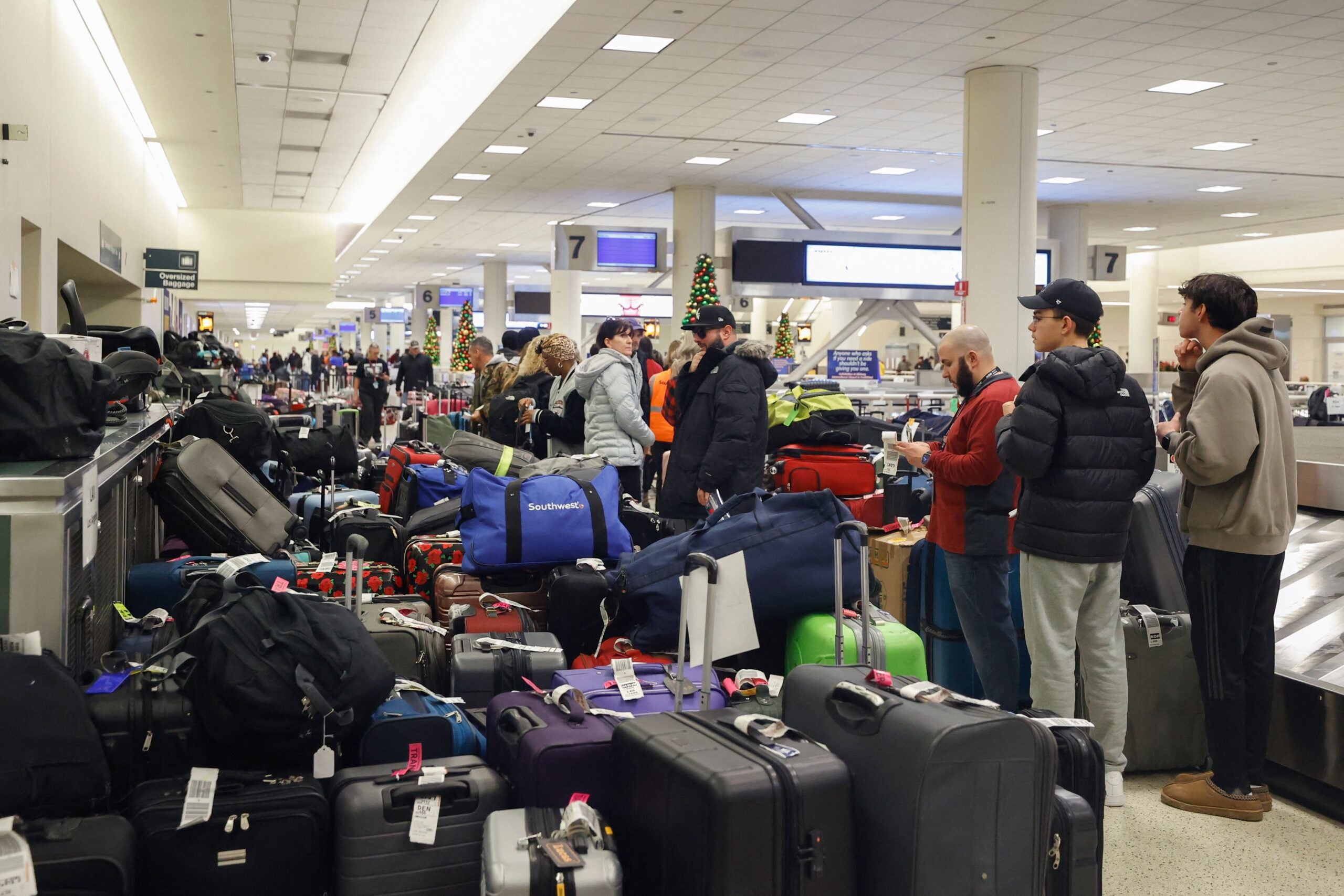Should you worry about another airline meltdown this year? Here’s what to know about holiday travel
With holiday travel coming up, travelers may be thinking back to last year, when a spate of severe winter storms grounded flights across the country just around Christmas, and an operational meltdown at Southwest Airlines dragged on for nearly a week after.
Given last year’s mess, many are likely wondering whether their travel plans could go off the rails again this year, whether because of a fresh round of storms or any of the other issues plaguing air travel, such as the ongoing air traffic controller shortage.
Want more aviation news? Sign up for TPG’s free biweekly Aviation newsletter.
Fortunately, things seem to be in a better place this year. Even so, airlines are always vulnerable to bad weather, and the right storm at the right time can still cause severe disruption of holiday travel. A key is whether or not airlines are able to recover from disruptions quickly.
Here’s what’s different at Southwest
During Southwest’s 2022 holiday meltdown, one of the biggest issues came in the days following the initial storm: The department that manages pilots’ and flight attendants’ schedules became overwhelmed. Pilots and flight attendants — left stranded out of position due to delayed and canceled flights — could not reach crew scheduling for hours to be reassigned to a different flight.
In the year since, the airline invested in new tools for crew scheduling, chief operating officer Andrew Watterson previously told TPG.
The airline has upgraded old software and added new programs that help the schedulers manage more displaced crew members at a time without being inundated. It makes it easier to reassign crew members to new flights automatically and offer different options when something goes wrong — for instance, instead of rescheduling a flight attendant on a new flight from their current location, working to get that crew member to somewhere that has a greater need for available flight crews.
The updates together solve last year’s issues of the crew scheduling system not being “able to technically handle these large-scale problems,” CEO Bob Jordan previously told TPG.
Meanwhile, the airline has addressed other issues that contributed to the 2022 mess.

Daily Newsletter
Reward your inbox with the TPG Daily newsletter
Join over 700,000 readers for breaking news, in-depth guides and exclusive deals from TPG’s experts
Flight delayed or canceled? Here are the best credit cards with trip delay reimbursement
Despite the storm being forecast several days ahead of time, the airline could not muster enough de-icing staff and equipment to keep planes moving, particularly in its focus city of Denver. Noting the wintry conditions during the holidays, some employees called out sick, marginally contributing to an already significant staffing challenge.
Over the past year, Southwest says it has hired and trained more employees who can handle de-icing duties during bad weather and significantly expanded its related infrastructure.
For instance, Southwest has added 30 new de-icing trucks across its system — 15 of those in Denver, where the problem was most acute last year — and reallocated its de-icing fleet around its airports based on need and capability, the airline told TPG. It’s also added 450 new employees at Denver and four new de-icing pads, bringing its total number of pads at the airport to 10.
The airline also says it has added staff so that during winter storms, as conditions outside deteriorate, employees can rotate in and out and take time to recover without slowing down the operation. More than 2,700 employees are trained to manage de-icing, the airline said.
Finally, the airline consolidated its network planning team and its operations control center, speeding up communication and allowing the airline to be more flexible in how it responds to early disruptions.
Returning routes: Southwest Airlines brings back 66 seasonal routes in summer schedule rollout
The benefits have already been apparent through several hurricanes earlier this year, the major travel weekends throughout the summer and fall, and, most tellingly, during an IT glitch in April that forced the airline to call a nationwide ground stop for nearly two hours.
While inconvenient — and poorly timed, given the recent memory of the holiday issue — the IT failure was not related to anything uniquely Southwest. Instead, it resembled the occasional system hiccups that every networked business experiences, including other airlines.
The glitch occurred during a busy weekday morning, which could have spelled disaster, leading to cascading delays and cancellations. But this time, it didn’t.
Complete tour: The brand-new Kansas City airport terminal brings major upgrades
In recent years, Southwest has handled events like this with a “hard reset” of its network, characterized by mass cancellations as it basically starts over from the beginning.
Instead, the airline decided to keep things going. According to Watterson in the interview earlier this year, longtime airline executive Adam Decaire, who recently took over as the head of the airline’s operations center, was able to liaise with crew scheduling and assess the network. He was able to decide that if the airline pushed, it could manage the day’s flights with only moderate delays and no impact spilling over into the next day.
It worked. While nearly 64% of the airline’s flights that day (2,640 flights) were delayed for an average of 45 minutes, only 18 were canceled — less than a half-percent, according to data from FlightAware. Things were mostly back to normal by the next day.
Unfortunately, there’s only so much that any airline can do to beat the weather. When there’s a storm, safety comes first, and flights won’t leave if conditions are bad enough. What all of the preparations do is help airlines get back in the skies when the worst of conditions have passed.
That means that ultimately, how a holiday travel season goes is really up in the air, depending on the forecast.
Holiday forecasts — weather and airlines
The holiday travel period is already starting off with a bang.
A major storm system is working its way up the East Coast as of Monday morning, bringing heavy rain and strong winds to some of the busiest airspace in the country. Areas from South Carolina all the way up through Maine could be affected across Monday and Tuesday, according to AccuWeather — New York City has already issued a travel advisory for the city through Monday.
As is often the case, delays in any part of the country, but particularly the Northeast, can spread as aircraft and crews get held up.
The good news is that as the week progresses, conditions are expected to improve.
The middle and latter part of this week will likely be calmer across the country, and much of the country will likely have a decent holiday travel period, AccuWeather forecasts. Still, forecasts can change, and it’s too soon to reliably predict the weather for the latter half of the holidays, so be sure to stay tuned to the weather.
The travel forecasts, however, are officially in. More than 115 million Americans are expected to travel between Dec. 23 and Jan. 1, AAA predicts, the second-busiest year-end travel period since 2000 — the busiest was 2019, with 119 million travelers. Of those, AAA expects 7.51 million to fly.
Where to next? Exciting new airline routes from November 2023 and beyond
The major airlines, meanwhile, all say they’re confident ahead of the rush, coming off of an overall successful Thanksgiving travel boom.
American Airlines said that it expects to carry 12.7 million passengers aboard 110,000 flights over the holidays, which it defines as Wednesday, Dec. 20, through Monday, Jan. 8, with the busiest day coming Friday, Dec. 22. A spokesperson for American noted that the 19-day-long holiday period is longer than what it’s defined in the past, “reflecting the changing travel habits of our customers and school schedules in many of American’s hub markets.”
“We’re closing out 2023 running the best operation in our airline’s history,” chief operating officer David Seymour said in a statement.
Delta Air Lines said it expects to fly nearly 9 million travelers between Thursday, Dec. 21, and Sunday, Jan. 7. The airline is similarly buoyed by a strong Thanksgiving performance, with just 12 flights canceled between Nov. 17 and 28.
“With a successful November and Thanksgiving operation behind us, Delta people are prepared to deliver a world-class experience for our customers over the holidays,” said chief operating officer Mike Spanos.
United Airlines also said it expects roughly 9 million passengers on nearly 4,000 daily flights over the holiday period, which it considers to be from Thursday, Dec. 21, to Monday, Jan. 8.
Interestingly, the airline noted that while many remote workers flew several days early for Thanksgiving, people have booked closer to the actual Christmas and New Year’s holidays, with Friday, Dec. 22, and Saturday, Dec. 23, as the busiest days surrounding Christmas, and Tuesday, Jan. 2, expected to be the busiest day around New Year’s.
Although the air traffic controller shortage is ongoing, things went well over Thanksgiving — something United CEO Scott Kirby was quick to praise — and hopefully can continue to run smoothly through the end of the year.
Related: ‘I think we’re going to win’: United CEO says airline is ready for industry’s challenges
The Federal Aviation Administration, which operates air traffic control nationwide, said that it’s ready for the surge. The agency said it expects to see as many as 48,959 flights across the nation per day, with that peak falling on Thursday, Dec. 21.
Tips for holiday travel
If you’re traveling for the holidays, be sure to leave extra time. Get to the airport early or leave a little further ahead for your drive. Consider leaving for the holidays or any other events a day or two earlier if you have the flexibility.
If you haven’t flown in a little while, make sure that your TSA PreCheck, Global Entry or Clear membership is active, and double-check that your Known Traveler Number is attached to your flight reservation.
Download and log in to your airline’s app if you’re flying, and check your reservation periodically to stay on top of any delays.
Keep an eye on TPG for the latest, and most importantly, have a happy holiday!
Related reading:

